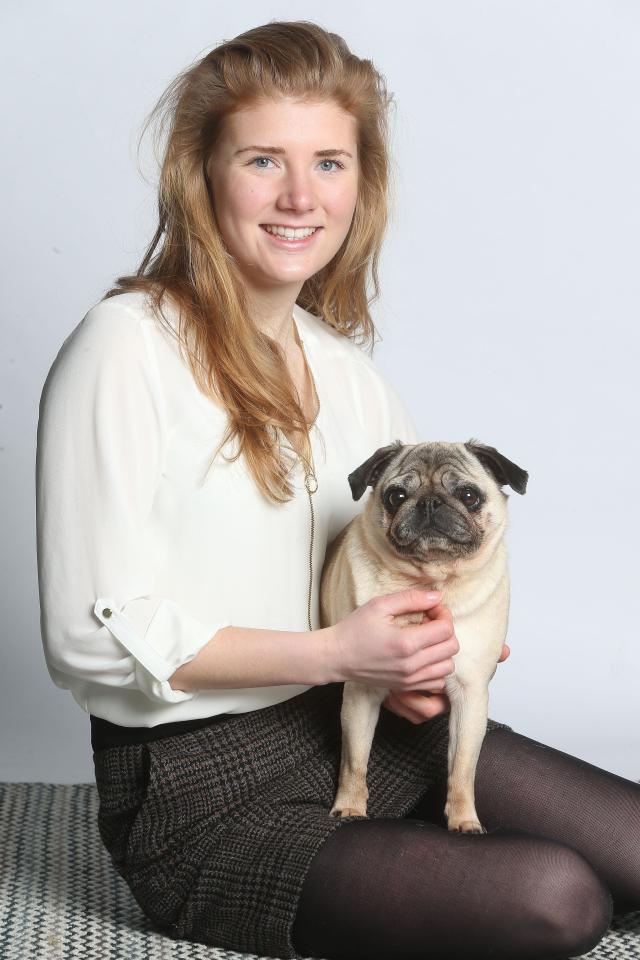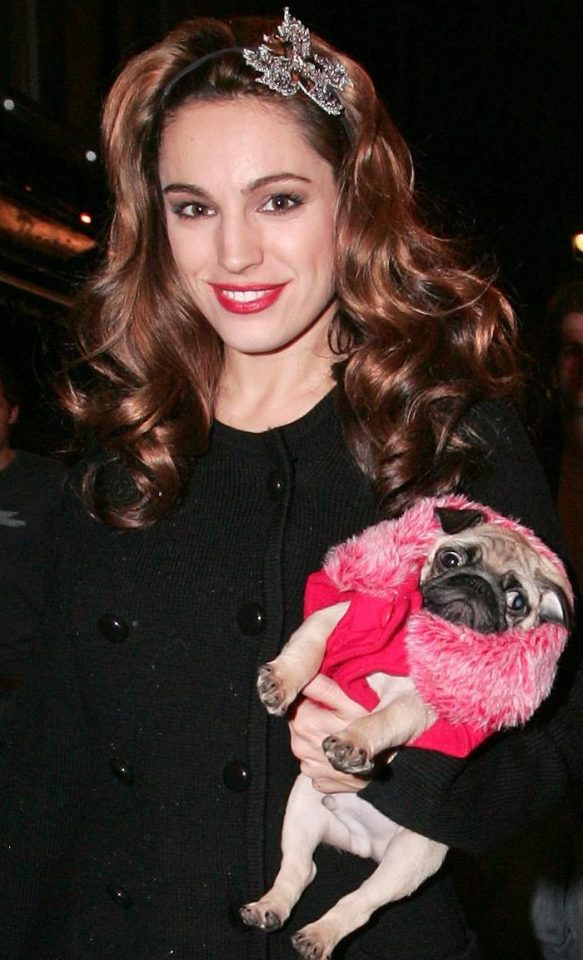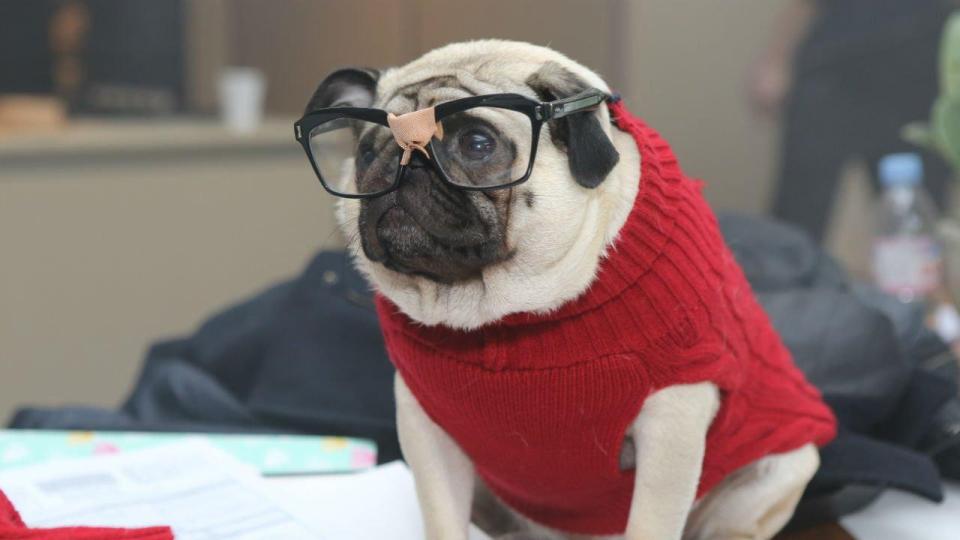Is our obsession with pugs cruel? Owners tells their heartbreaking stories
Greeting cards, memes and celebrities are boosting demand for the frail pups

EVER since she was a little girl, Evelyn Hanes dreamed of bringing home her very own pug puppy.
But when she finally got her wish aged 12, the reality rapidly turned into a nightmare.
Little puppy Ruby immediately began to exhibit crippling health problems — which is sadly common among Britain’s fourth most common dog breed.
Demand for pugs has been driven by celebrity owners, including Paris Hilton and Kelly Brook, and their use in advertising to sell everything from Valentine’s cards to glasses and mobile phone plans. But today the British Veterinary Association is urging card makers to stop using pictures of them.
The industry knows that dog lovers are drawn to their squashed faces, bulging eyes and wrinkly skin.
But it is these very features — deliberately bred into pugs so they meet an ideal — that cause a catalogue of problems, including difficulty with breathing and walking, that can see them suffer a life of misery. And this can lead to huge vets’ bills.
A whopping 10,408 were registered here in 2016, up from 3,547 in 2007. Experts fear the surge in demand is encouraging breeders with no interest in the animals’ health to cash in.
Vet Robin Hargreaves, who has his own surgery in Colne, Lancs, has seen a huge increase in pugs with breathing issues.
He said: “Most owners, who love their animals, are blinded to the problem. They think the snoring and snuffling is endearing and they don’t equate it with struggling to breathe.
“Their nasal passages are so thin that it’s like breathing through a straw. The quality of life is intolerable without surgery — and surgery makes it just bearable.
“The principal solution to the problem is to not buy this breed.”
Donna Woodford, 47, from Alder-shot, Hamp-shire, runs dog rescue charity Pro Dogs Direct and has taken in two pugs given up for rehoming.
She says: “I always tell people, ‘Don’t ever buy a pug, they’re not fit for purpose’.”
This is a lesson Evelyn, from Cheltenham, Gloucs, learned as soon as she picked up her longed-for pet.
She says: “When we went to see Ruby at the breeder’s home, I remember thinking, ‘She’s a lovely small dog and so cute’. But in the car home she started breathing like a pig.
“I turned to my dad and said, ‘What have we bought? Is she supposed to sound like this?’.”
Now 20 and a geology student, Evelyn adds: “All I could think was, ‘My poor little dog. Does she have to live with this for the rest of her life?’.
“From the beginning, Ruby struggled to breathe and at three she had her first epileptic fit. Her face froze, her legs went stiff and she dropped to the floor and was foaming at the mouth, convulsing.
“It was absolutely horrible to watch and we rushed her to the vet.”
The family was told that epilepsy was common in pugs due to a lack of oxygen in the brain, caused by problems associated with breeding them to have short skulls.
But the likely health problems do not end there. A recent study published in the Veterinary Record journal found that one in three suffer walking difficulties. Their squashed faces cause their breathing problems and their bulging eyes leave them prone to eye ulcers.
Their curled tails are linked with spinal defects and their folded skin leads to dermatitis and infection.
Bill Lambert, health and breeder services manager at dog welfare organisation The Kennel Club, says: “At one time pugs were dogs bred by specialist breeders. But now they’ve exploded in popularity it’s left a gap in the market which has been filled by those who are there to turn a quick buck.
“Some are just careless and uninterested in the health issues, and many are hard-hearted smugglers and puppy farmers who churn out these dogs purely for profit.
“The puppy buyer has a huge part to play in this problem. We live in a culture of instant grat-ification but if you want a pedigree puppy from a reputable breeder then do your research on our assured breeders scheme and be prepared to wait.”
Dogs Trust vet Catherine Dobbie adds: “It’s really important to think long and hard when purchasing a puppy.
“Many people think that, because of their size, pugs are an easy, low-maintenance dog. They’re not.
“Are you prepared to clean their skin folds every week and keep on top of their eye care? Can you afford the vet bills?”
Pug owner Donna has already forked out £6,000 on health fees for her pair, Peppa and Dizzy.
She says: “Peppa had a nose job but she still pants and gasps. People think it’s normal for a pug to make these noises but it’s not normal and it’s not healthy.
“Peppa is a rescue and came to live with me when she was six months old. She had chronic demodex, which is a mite infection, open sores and hair loss.
“Sadly, pugs are prone to suffering from skin issues in general and Peppa has regular medication to keep on top of this problem.
“She also has luxating patellas, which means that her kneecaps come in and out of her joints. One of Peppa’s knees has been operated on and she’ll have the other knee done when it’s the right time.
“Dizzy came to live with me eight months ago after being given up for adoption.
“Sadly, I’m seeing more pugs being handed over for rehoming and one of the reasons is the dogs’ health issues. People just aren’t prepared for the ongoing costs of treatment.
“Why do pugs have these health issues in the first place? It’s down to poor breeding. Take my two pugs. When it’s warm I can’t walk them outside in the heat because it would kill them. They have such short noses that they struggle to breathe at the best of times.”
It is believed that pugs are derived from Chinese happa dogs brought over to Britain by the Portuguese between the 15th and 16th centuries.
They were crossed with terriers and smaller dogs to give them their signature flat face. A hundred years ago, pugs were slimmer and taller, with a small but defined snout.
But selective breeding towards today’s “ideal” has caused them to develop a squished face, stockier abdomen and a double curled tail.
Catherine says: “They appeal to people because of their cuteness — that very flat face gives them a human appearance.
“But those sweet, protruding eyes cause ulcers and that spiral tail leads to spinal issues.
“I think you have to say that the drive to breed them for this certain look is causing problems.”
Pugs are one of the brachycephalic breeds, meaning short-nosed, which also include cavalier King Charles spaniels and French bulldogs.Their use in adverts is driving their appeal, according to the Brachycephalic Working Group, which aims to improve the welfare of all flat-faced breeds.
Chairman Dr Dan O’Neill says: “There is a real concern that the use of pugs in advertisements is fuelling the popularity of these breeds and is widening the market for those who simply wish to make money from these dogs with little or no regard for their health and wellbeing.
“These dogs are essentially being abused by advertisers, because as well as advertising the product they are also advertising the breed.
“And they can suffer from some horrible long-term health conditions.”
MOST READ IN UK NEWS
This Valentine’s Day the British Veterinary Association has urged the card industry to stop using snaps of the pugs.
President John Fishwick said: “Pugs and many other flat-faced dogs have lovely temperaments, but the use of their images on cards and gifts is ‘normalising’ these breeds’ short noses and big eyes, which can cause horrendous pain for the animal and prove costly for the owner to treat.”
So if you really want to show some puppy love this Valentine’s Day, then it might be best to avoid pugs altogether.
- GOT a story? RING The Sun on 0207 782 4104 or WHATSAPP on 07423720250 or EMAIL [email protected]

















